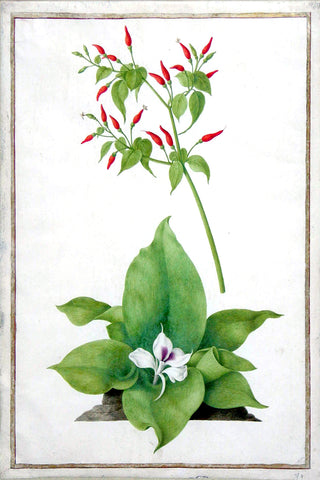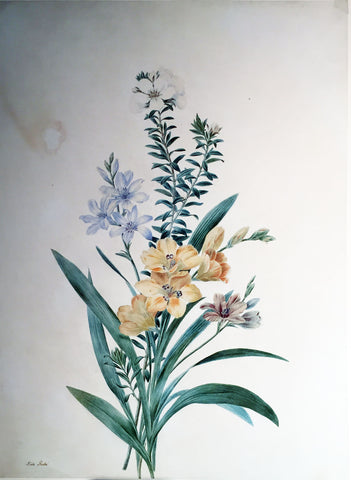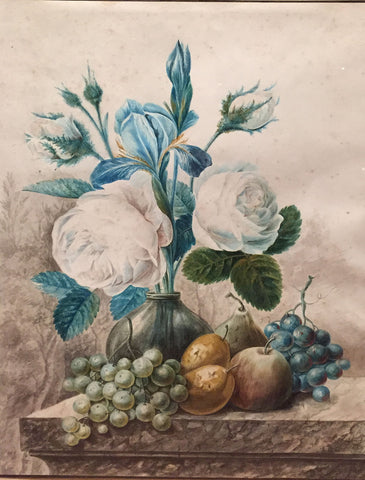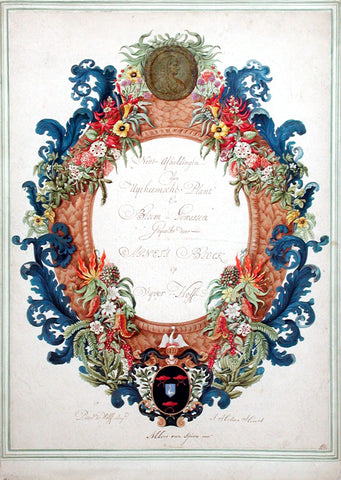
Nicolas Robert (French, 1614-1685), A Study of a Member of the Bromelia family and a subsidiary study of a Chili Pepper
Nicolas Robert (French, 1614-1685)
‘A Study of a Member of the Bromelia family and a subsidiary study of a Chili Pepper (Capsicum frutensis)
Pencil, watercolor and body color on prepared vellum, with pencil, gold and brown ink framing lines
Annotated l.r. ‘26.’, ‘79.’
ca. 1670
Vellum size 16 x 11 1/2 in
Frame size 27 x 22 in
This sheet is part of a larger series of drawings of comparable subject, format and technique, by Nicholas Robert, possibly the greatest Natural History artist in France in the 17th century. He was particularly known for his watercolors of plants and flowers done on prepared vellum. The largest collection of comparable drawings by him is preserved in the Musee d’Histoire Naturelle, Paris, while others are preserved in the British Museum, London; the Fitzwilliam Museum, Cambridge; and in the Hofbibliothek, Vienna. The Paris group forms the nucleus of a collection traditionally known as the Velins du Museum, originally called the Velins du Roy counting more than six thousand watercolors. The Collection was started by the brother of King Louis XIII, Gaston d’Orleans (1608-1660), who had been exiled at Blois due to his perpetual intrigues against the king. In Blois, he developed his talent as a botanist and soon his garden there was well-known. He employed several artists to make watercolors of the rarest species he assembled.
Following a small series of etchings published in Italy, Nicolas Robert had been commissioned in 1641 a book of vellum watercolors of flowers inscribed with madrigals, called Gurilande de Julie. This was the betrothal offering given by Charles Baron de Sante-Maure (1610-1690) to Julie d’Angennes (1607-1671), daughter of Marquise de Rambouillet. Gaston d’Orleans subsequently commissioned a large series of drawings from Robert, which were preserved in five large portfolios. Following Gaston’s death in 1660, it was the King’s minister Colbert who ensured that the series was expanded. Robert was appointed Peitre ordinaire du Roi pour la miniature in 1666 with the obligation to produce at least 54 velins annually.
Dr. Sam Segal has kindly identified the species. He points out that the Bromeliaceae is known in some 2,000 variations, mostly found on trees in tropical rainforests (epiphytes). Another member of this family is the pineapple. The Chilli pepper was brought from South America to India by the Portuguese, where it is still a main ingredient of the local food. It is also used for the production of Tobasco.
Nicolas Robert was one of the greatest natural history artists of the seventeenth-century, and his work established standards combining scientific accuracy and aesthetic appeal that influenced generations of artists and won the respect and patronage of the French royal family. Robert created a vast, exquisite body of work for the French Crown. Along with other artists, Robert was commissioned by Gaston d’Orleans, brother of Louis XIII, to create watercolors of the rare plants and exotic birds he had assembled in his garden at Blois and the Ménagerie at Versailles. Robert’s talent was recognized quickly as being superior to that of other artists working for the royal family, and after Gaston d’Orleans’s death, he was quickly placed under the patronage of the Sun King, Louis XIV. As a reward for the stunning works he painted for the king’s personal collection, Robert was named Peintre Ordinaire du Roiinches in 1666, a title that confirmed his continuing fame and patronage.
Robert was the first significant contributor to a collection of fine watercolors on vellum that became known, collectively, as the Velins du Roi (the King’s Vellums). The watercolors Robert completed under Gaston d’Orleans and then Louis XIV for the royal collection fed the interest and provided the inspiration for the great masters of botanical and ornithological art who followed: Jean Joubert, Nicholas Marechal, Gerard van Spaendonck and, of course, Pierre-Joseph Redouté. Thus, the extremely fine print work of Parisian natural historians and flower painters as late as 1825 can be traced directly back to the strength of Robert’s tradition.
Recognizing the greatness of the Velins, Napoleon Bonaparte continued work on this monumental and exquisite undertaking and these remarkable works were probably completed by Robert under his patronage.
Please feel free to contact us with questions by phone at 215.735.8811,
or by email at loricohen@aradergalleries.
We Also Recommend





